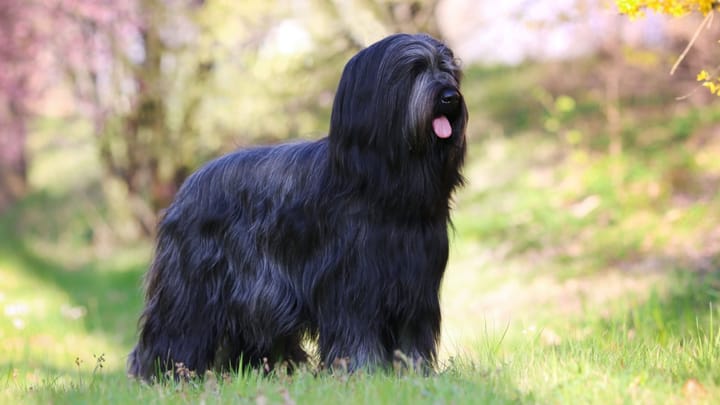Briard
Other names : Berger de Brie, Berger Briard


The Briard is a breed of herding dog from France. It is said to have come about in the 1300s. They were originally used to herd and guard flocks of sheep. More recently they have been (and in some places are still) used as farm dogs. They are exceptionally alert and confident animals but they have a tendency to be ‘on edge’.
|
Life expectancy |
The Briard has a life expectancy of between 10 and 12 years |
|
Temperament |
|
|
Size |
Large
|
|
Adult size |
Female
Between 22 and 25 in
Male
Between 24 and 27 in
|
|
Adult weight |
Female
Between 66 and 88 lb
Male
Between 66 and 88 lb
|
|
Coat colour
This dog is seen of black, fawn, grey and blue. |
Black Blue |
|
Type of coat
A long double coat consisting of a long and coarse outer coat and a fine undercoat. |
Long |
|
Eye colour
Dark. |
Brown
|
|
Purchase price |
The Briard costs between £600 and £1 |
Think you’ve never seen one before? Think again. Tramp from My Three Sons was a Briard! So were Stinky, from Dharma & Greg, and Buck from Married...With Children.
More details about the Briard
Briard: Origins and history
First bred it is thought in the Middle Ages, the Briard has been depicted in art and literature ever since. After the French Revolution, the Briard gained popularity among farmers who considered the dog perfect for herding and guarding sheep. During WW1 the dog was put to use as a sentry and was the official dog of the French army.
Physical characteristics of the Briard
This is a dog of medium to large build, stocky but not bulky. Its skull and muzzle are well-proportioned. The ears are set high and are usually small. The tail is carried low to the hocks when the dog is inactive but about level with the top-line when the dog is moving.
FCI classification of the Briard
-
Group 1 - Sheepdogs and Cattledogs (except Swiss Cattledogs)
-
Section 1 : Sheepdogs
Briard: Characteristics
Briard: Behaviour
Training a Briard
The Briard is a challenge to train. A confident master who consistently varies the dog’s training is needed. Briards get easily bored of routine.
Briard: Lifestyle
Breed compatibility Briard
Briard: Purchase price
A purebred Briard puppy may cost you anywhere from £600 to £1,000. It will cost between £110 and £160 per month to keep a dog of this breed.
Briard: Shedding
None
The Briard sheds lightly throughout the year. In warmer months it sheds more plentifully.
Briard: Grooming
A thorough brush at least three times a week is called for of this dog. Doing so prevents the thick coat from matting and becoming tangled. It is also a good way to relieve the coat of all the debris it has picked up on the dog’s travels. The Briard’s coat is notoriously adept at collecting mud, plant seeds and insects.
Briard: Health
The Briard is generally healthy and robust but is prone to ailments linked to genetic inbreeding. Its life expectancy is 10 to 12 years.
A Briard will not care what the weather is like as long as it is outdoors. This is a brave and adventurous dog that can walk for miles at a time.
The Briard does not tolerate hot weather overly well. A ‘thin and trim’ haircut will help the dog to get through the hottest time of the year.
The double coat of the Briard keeps the dog warm in bad weather.
Weight gain can be a feature of the Briard. If your Briard is not exercised as regularly as it should be and is fed too much human or substandard food it will become obese.
- Hip dysplasia
- Bloat
- Cataracts
- Retinal atrophy
- Congenital stationary night blindness
- Hypothyroidism
- Lymphoma






